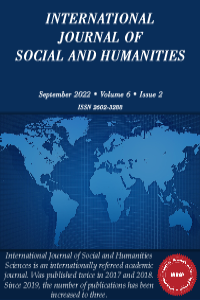Abstract
Our study concerns the analysis of a corpus composed of a set of extracts of articles of national and international electronic press. It is of capital importance because it has a discursive faculty and vector of social forces. To this end, it deals with the boycott as a main theme that unites a set of areas from which the topics discussed therein converge, namely: social, educational and political. In this sense, we plan to study the discursive strategies used in the corpus and see their impact on the different linguistic movements related to the notion of boycott. In other words, we will target the protest movements that run through the social networks. This kind of movement wants to be free and does not require a leader, contrary to the traditional protest which requires the affective presence of a leader. In review of what is said, we have contingent and defined the corpus by taking stock of its suitability with the following points: - The discursive function of the analysed corpus and its status as a vector of social forces. -The nature and impact of the various calls for boycott on social networks.
Keywords
References
- Adam, J-M. (1997). Unités rédactionnelles et genres discursifs : cadre géné-ral pour une approche de la presse écrite. in Pratiques n°94.
- Arrive, M et al. (1986). La grammaire d’aujourd’hui : guide alphabétique de linguistique française. Paris : Flammarion, p55.
- Bourdieu, P et Saint-Martin, M. (1976). Anatomie du goût. Actes de la recherche en sciences sociales. vol. 2, no 5, octobre 1976 , p 10.
- Charaudeau, P. (1997). Le discours d'information médiatique - La construc-tion du miroir social. Nathan.
- Charaudeau, P. (2005). Le discours politique, les masques du pouvoir. Pa-ris, Vuibert.
- Courtes, J. (2007). La sémiotique du langage. Paris. Armand colin.
- Deroubaix, J-C. (1997). Les déclarations gouvernementales en Belgique (1944-1992). Étude de lexicométrie politique. Université de la Sorbonne nou-velle - Paris III.
- Garric, N et Longhi, J. (2012). L'analyse de corpus face à l'hétérogénéité des données : d'une difficulté méthodologique à une nécessité épistémologique. https://www.cairn.info/revue-langages-2012-3-page-3.htm. Article consulté le 22 novembre 2020.
- Gobin, C. (2011). Des principales caractéristiques du discours politique contemporain. Semen [En ligne], 30 | 2011, mis en ligne le 01 janvier 2011, con-sulté le 15 décembre 2020. URL : http://journals.openedition.org/semen/9018 ; DOI : https://doi.org/10.4000/semen.9018.
- Bergevin, J. (1983). Pour comprendre la « théorie générale » de la société de Robert FOSSAERT : étude schématique. Cahiers de géographie du Québec, 27 (70), 79–97. https://doi.org/10.7202/021589ar.
- Maingueneau, D. (2005). L’analyse du discours et ses frontières. Marges Linguistiques, 9, mai, p. 64.
- Riegel, M et al. (1994). Grammaire méthodique du français. Paris : PUF. P 68.
- Robert, P. Rey-debove, J et Rey, A(éd.), (2016). Le Petit Robert : diction-naire alphabétique et analogique de la langue française. Nouv. éd. millésime 2014. Paris : Le Robert. https://www.leparisien.fr/economie/appel-au-boycott-5-minutes-pour-comprendre-son-impact-economique-sur-les-produits-francais-26-10-2020-8405074.php.
Abstract
Çalışmamız, ulusal ve uluslararası elektronik basın makalelerinden bir dizi alıntıdan oluşan bir külliyatın analizine odaklanmaktadır. Söylemsel bir güce sahip olduğu ve sosyal güçlerin bir vektörü olduğu için büyük önem taşımaktadır. Bu amaçla, boykotu, içinde ele alınan konuların birleştiği bir dizi alanı, yani sosyal, eğitimsel ve politik alanları birleştiren bir ana tema olarak ele almaktadır. Bu anlamda, derlemde kullanılan söylemsel stratejileri incelemeyi ve bunların boykot kavramıyla ilgili farklı dil hareketleri üzerindeki etkilerini görmeyi planlıyoruz. Başka bir deyişle, sosyal ağlar boyunca devam eden protesto hareketlerini hedef alacağız. Bu tür bir hareket özgürdür ve bir liderin duygusal varlığını gerektiren geleneksel protestoların aksine bir lidere ihtiyaç duymaz. Söylenenleri gözden geçirirken, külliyatı aşağıdaki noktalara uygunluğunu değerlendirerek koşullandırdık ve tanımladık: - Analiz edilen külliyatın söylemsel işlevi ve sosyal güçlerin bir vektörü olarak statüsü. -Sosyal ağlarda boykot için yapılan çeşitli çağrıların doğası ve etkisi.
Keywords
References
- Adam, J-M. (1997). Unités rédactionnelles et genres discursifs : cadre géné-ral pour une approche de la presse écrite. in Pratiques n°94.
- Arrive, M et al. (1986). La grammaire d’aujourd’hui : guide alphabétique de linguistique française. Paris : Flammarion, p55.
- Bourdieu, P et Saint-Martin, M. (1976). Anatomie du goût. Actes de la recherche en sciences sociales. vol. 2, no 5, octobre 1976 , p 10.
- Charaudeau, P. (1997). Le discours d'information médiatique - La construc-tion du miroir social. Nathan.
- Charaudeau, P. (2005). Le discours politique, les masques du pouvoir. Pa-ris, Vuibert.
- Courtes, J. (2007). La sémiotique du langage. Paris. Armand colin.
- Deroubaix, J-C. (1997). Les déclarations gouvernementales en Belgique (1944-1992). Étude de lexicométrie politique. Université de la Sorbonne nou-velle - Paris III.
- Garric, N et Longhi, J. (2012). L'analyse de corpus face à l'hétérogénéité des données : d'une difficulté méthodologique à une nécessité épistémologique. https://www.cairn.info/revue-langages-2012-3-page-3.htm. Article consulté le 22 novembre 2020.
- Gobin, C. (2011). Des principales caractéristiques du discours politique contemporain. Semen [En ligne], 30 | 2011, mis en ligne le 01 janvier 2011, con-sulté le 15 décembre 2020. URL : http://journals.openedition.org/semen/9018 ; DOI : https://doi.org/10.4000/semen.9018.
- Bergevin, J. (1983). Pour comprendre la « théorie générale » de la société de Robert FOSSAERT : étude schématique. Cahiers de géographie du Québec, 27 (70), 79–97. https://doi.org/10.7202/021589ar.
- Maingueneau, D. (2005). L’analyse du discours et ses frontières. Marges Linguistiques, 9, mai, p. 64.
- Riegel, M et al. (1994). Grammaire méthodique du français. Paris : PUF. P 68.
- Robert, P. Rey-debove, J et Rey, A(éd.), (2016). Le Petit Robert : diction-naire alphabétique et analogique de la langue française. Nouv. éd. millésime 2014. Paris : Le Robert. https://www.leparisien.fr/economie/appel-au-boycott-5-minutes-pour-comprendre-son-impact-economique-sur-les-produits-francais-26-10-2020-8405074.php.
Details
| Primary Language | English |
|---|---|
| Journal Section | Research Article |
| Authors | |
| Publication Date | October 20, 2022 |
| Published in Issue | Year 2022 Volume: 6 Issue: 2 |

